
Geum, commonly called avens, is a genus of about 50 species of rhizomatous perennial herbaceous plants in the rose family and its subfamily Rosoideae, widespread across Europe, Asia, North and South America, Africa, and New Zealand. They are closely related to Potentilla and Fragaria. From a basal rosette of leaves, they produce flowers on wiry stalks, in shades of white, red, yellow, and orange, in midsummer. Geum species are evergreen except where winter temperatures drop below 0 °F (−18 °C). The cultivar 'Mrs J. Bradshaw' has the Royal Horticultural Society's Award of Garden Merit.

Dryas is a genus of perennial cushion-forming evergreen dwarf shrubs in the family Rosaceae, native to the arctic and alpine regions of Europe, Asia and North America. The genus is named after the dryads, the tree nymphs of ancient Greek mythology. The classification of Dryas within the Rosaceae has been unclear. The genus was formerly placed in the subfamily Rosoideae, but is now placed in subfamily Dryadoideae.
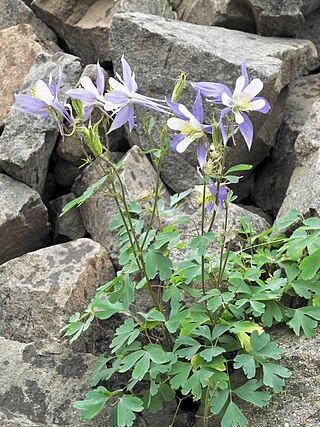
Aquilegia coerulea, the Colorado columbine, Rocky Mountain columbine, or blue columbine, is a species of flowering plant in the buttercup family Ranunculaceae, native to the Rocky Mountains and some of the surrounding states of the western United States. It is the state flower of Colorado. The Latin specific name coerulea means "sky blue".
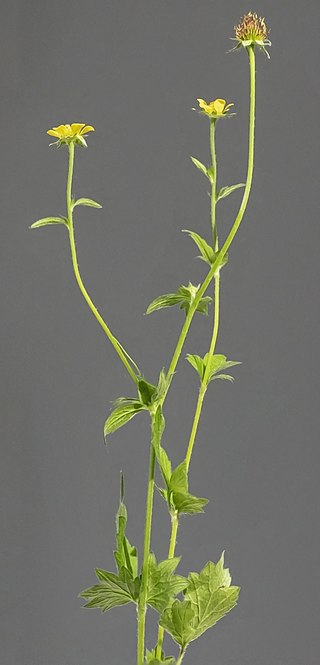
Geum urbanum, also known as wood avens, herb Bennet, colewort and St. Benedict's herb, is a perennial plant in the rose family (Rosaceae), which grows in shady places in the temperate regions of Eurasia and North America.
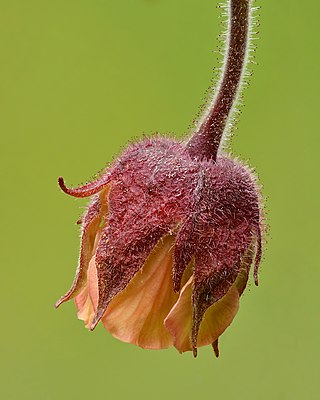
Geum rivale, the water avens, is a flowering plant in the genus Geum within the family Rosaceae. Other names of the plant are nodding avens, drooping avens, cure-all, water flower and Indian chocolate. It is native to the temperate regions of Europe, Central Asia and parts of North America, where it is known as the purple avens. It grows in bogs and damp meadows, and produces nodding red flowers from May to September.

Geum macrophyllum, commonly known as largeleaf avens or large-leaved avens is a flowering plant found from the Arctic south to the northern U.S. states, and in the Rocky Mountains and west to the Sierra Nevada in California and as far south as Northwestern Mexico.
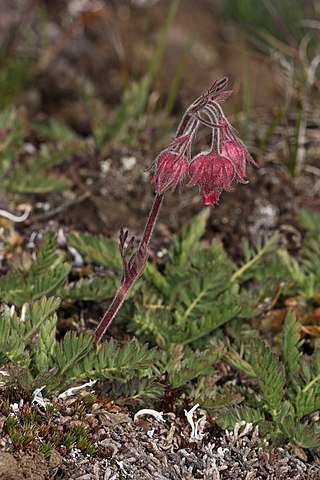
Geum triflorum, commonly known as prairie smoke, old man's whiskers, torchflower, three-sisters, long-plumed purple avens, lion's beard, or three-flowered avens, is a spring-blooming perennial herbaceous plant of the Rosaceae family. It is a hemiboreal continental climate species that is widespread in colder and drier environments of western North America, although it does occur in isolated populations as far east as New York and Ontario. It is particularly known for the long feathery plumes on the seed heads that have inspired many of the regional common names and aid in wind dispersal of its seeds.

Eriogonum umbellatum is a species of wild buckwheat known by the common name sulphurflower buckwheat, or simply sulphur flower.

Ribes aureum, known by the common names golden currant, clove currant, pruterberry and buffalo currant, is a species of flowering plant in the genus Ribes native to North America.

Potentilla diversifolia or Potentilla × diversifolia is a species of flowering plant in the Rose Family (Rosaceae) known by the common names varileaf cinquefoil, different-leaved cinquefoil, and mountain meadow cinquefoil.

Ribes cereum is a species of currant known by the common names wax currant and squaw currant; the pedicellare variety is known as whisky currant. The species is native to western North America.
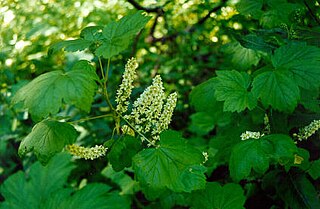
Ribes hudsonianum is a North American species of currant, known by the common name northern black currant.
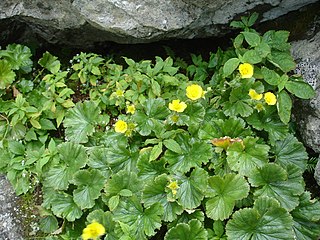
Geum radiatum is a rare species of flowering plant in the rose family known by the common names spreading avens, Appalachian avens, and cliff avens. It is native to the region of the border between Tennessee and North Carolina in the southeastern United States, where there are eleven known populations remaining. The plant was federally listed as an endangered species in 1990.
Primula capillaris is a rare species of flowering plant in the primrose family known by the common name Ruby Mountains primrose, or Ruby Mountain primrose. It is endemic to Nevada in the United States, where it is limited to the Ruby Mountains of Elko County.
Aliciella sedifolia is a rare species of flowering plant in the phlox family known by the common name stonecrop gilia. It is endemic to Colorado in the United States, where it is limited to a small area in the San Juan Mountains.
Geum geniculatum is a species of flowering plant in the rose family known by the common name bent avens. It is endemic to the southern Appalachian Mountains in the United States, where it occurs on only five mountains: Grandfather Mountain, Snake Mountain, and Rich Mountain in North Carolina, Roan Mountain straddling the North Carolina-Tennessee border, and Whitetop Mountain in Virginia.
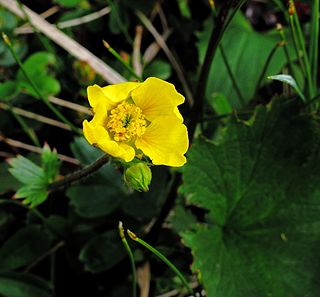
Geum peckii is a species of herbaceous, perennial flowering plant in the rose family known by the common name mountain avens. It is native to eastern North America, where it is known from only two locations, the White Mountains of New Hampshire and three sites in Nova Scotia.
Draba graminea is a species of flowering plant in the mustard family known by the common names Rocky Mountain draba and San Juan Whitlow-grass. It is endemic to the state of Colorado in the United States, where it is limited to the San Juan Mountains.















